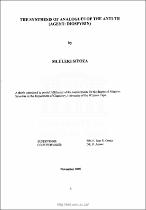| dc.contributor.advisor | Green, Ivan R. | |
| dc.contributor.author | Sitoza, Mluleki | |
| dc.date.accessioned | 2023-06-13T11:39:04Z | |
| dc.date.available | 2023-06-13T11:39:04Z | |
| dc.date.issued | 2005 | |
| dc.identifier.uri | http://hdl.handle.net/11394/10213 | |
| dc.description | >Magister Scientiae - MSc | en_US |
| dc.description.abstract | Diospyrin, a bisnaphthyl quinone molecule with proven anti-TB activity can be retrosynthetically formulated into two halves. In this work, the analogue chosen to be synthesized was similarly retrosynthesized into two halves. The one half, 2-bromo-5- methoxy-1 ,4-naphthoquinone was synthesized successfully starting from 1,5- diacetoxynaphthalene which was oxidized and brominated with N-bromosuccimide to the corresponding 5-acetoxy-2-bromo-1,4-naphthoquin one. Hydrolysis of the acetoxy group was effected with methanolic potassium hydroxide followed by methylation of the phenolic group by methyl iodide and silver (II) oxide. The second half of the analogue, 7-bromo-1,4,6-trimethoxynaphthalene was attempted to be synthesized in the following way. Condensation between benzoquinone and Danishefsky's diene afforded an adduct which after much investigation was converted into 1,4,6-triacetoxynaphthalene. Through the process of transformations viz., oxidation, hydrolysis and phenol protection, the triacetoxynaphthalene was converted into 6- hydroxy-1,4-dimethoxynaphthalene. Attempts to brominate both this latter phenol as well as the original Diels-Alder adduct at C-7 proved to be problematic but gave some interesting results. Finally, by converting the 6-hydroxy-1,4-dimethoxyna phthalene into the corresponding carbamate, it could be transformed into the C-7 boronic acid albeit in low yield. Intwo reference Suzuki coupling experiments, the boronic acid derived from the carbamate of phenol was condensed with 2-bromo-1,4-dimethoxybenzen e and 6- methoxynaphthyl-2-boronic acid was coupled with 2-bromo-5-methoxy- 1,4- naphthoquinone. Finally, Suzuki coupling between 2-bromo-5-methoxy-1,4-naphthoquino ne and C-7 boronic acid of 6-(N,N-diethylcarbamyloxy) -1,4-dimethoxynaphthalene proved to be problematic with a very low yield of biaryl product being detected. | en_US |
| dc.language.iso | en | en_US |
| dc.publisher | University of the Western Cape | en_US |
| dc.subject | Diospyrin | en_US |
| dc.subject | Mycobacterium tuberculosis | en_US |
| dc.subject | 2, 5 -Dibromobenzoquinone | en_US |
| dc.subject | 2 -Bromo-S -methoxynaphthoquinone | en_US |
| dc.subject | 6-Hydroxy- 1,4-dimethoxynaphthalene | en_US |
| dc.subject | Bromination of 6-hydroxy- 1,4-dimethoxynaphthalene | en_US |
| dc.subject | 6-N,N-Diethylcarbamyloxy- 1,4-dimethoxynaphthalene | en_US |
| dc.subject | 6-N,N-diethylcarbamyloxy- 1,4-dimethoxy-7-naphthylboronic acid | en_US |
| dc.subject | 5 -Methoxy -2-(6' -methoxynaphth- 2-yl) - 1,4'naphthoquinone | en_US |
| dc.subject | 5-Methoxy-2-[7'-(6'-N,N-diethylcarbamyloxy)-1',4'-dimethoxynaphthyl]-1,4- naphthoquinone | en_US |
| dc.title | The synthesis of analogues of the Anti-TB (agent: Diospyrin) | en_US |
| dc.rights.holder | University of the Western Cape | en_US |

